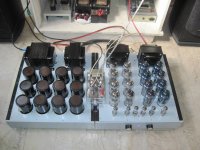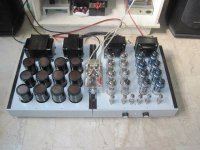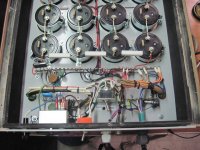"And you'd think that none of this would make it past the filter caps, but then again noise can be transmitted via common mode which could be picked up by an external measuring instrument but which wouldn't be present in the currents driving the load necessarily."
Electrolytics are quite inductive above a few hundred kHz, so high frequency rectifier crud could sail right past them into the rest of the circuit. Simply bypassing with film caps isn't a panacea either because that could set up a nasty resonant tank if the big cap has low enough series resistance.
Electrolytics are quite inductive above a few hundred kHz, so high frequency rectifier crud could sail right past them into the rest of the circuit. Simply bypassing with film caps isn't a panacea either because that could set up a nasty resonant tank if the big cap has low enough series resistance.
Does anyone really think they can hear the difference in a well designed power supply?
Why not, if a fuse change can be heard, or a mains cable, or a mains socket change?
There is a moment, 100 or 120 times every second, just when the diodes are on, that all those elements are VERY directly coupled to your speakers, perhaps more that any other signal. Being the diodes the closest element, as they are in the nearest side of the trafo, it seems that they should have some influence.
Talking about LPS, of course.
Best Regards.
If it's as stated, a "well designed" power supply, I'd be surprised if any of these changes could be detected in a DBT.Why not, if a fuse change can be heard, or a mains cable, or a mains socket change?
There was some recent power supply "did away" with that direct-connection-during-forward-diode-conduction thing by only pulling current from the main capacitors (presumably to charge some other downstream capacitors) at times other than when the diodes were conduction. I recall it was discussed on DIYaudio in the last year or two, and I remember an article or blurb on it using this sort of language of "your whole system is directly connected to the power line when the rectifiers are forward conducting" and how this special power supply was the solution.There is a moment, 100 or 120 times every second, just when the diodes are on, that all those elements are VERY directly coupled to your speakers, perhaps more that any other signal.
But I can't imagine anything on the line and coming through the transformer and diodes being as bad as the actual 120Hz sawtooth wave that's always at the main filter capacitors. Even so, some RF filtering and flyback suppressor circuitry is a lot cheaper than that fancy power supply that prevents the dreaded "direct connection to the power line."
Member
Joined 2006
www.diyaudio.com/forums/power-supplies/319082-applying-gan-transistor-replacement-sic-rectifier.html
Si -> SiC -> GaN
Ahead of time. 🙂
Si -> SiC -> GaN
Ahead of time. 🙂
I think erin hear maybe a difference of voltage operation when he used the other part.
Personally, The only thing I could perceive and measure is a sag in inadequate rectifiers with tubes.
What you hear is maybe not related to the rectifier quality but the output voltage for a DAC.
Your mind can play some tricks on you!
1n4007, doubled for bigger amps with capacitor equalization can surge any peak amplifier demands especially if doubled to 2 amps
If you are building a mega thousands of dollar amplifier, yes a 2.5$ specialty SiC diode is justified... I have those which can give 0 reverse current, smallest capacitance, a + T coef on Vf, able to switch to 1mhz and withstand solid state rectifiers power sequence with over 1000V peak surges.
If the 1n4007 sound bad, then I am going to go build planes.
(choke input? warrrrggg noooo, don't do this please! )
)
Personally, The only thing I could perceive and measure is a sag in inadequate rectifiers with tubes.
What you hear is maybe not related to the rectifier quality but the output voltage for a DAC.
Your mind can play some tricks on you!
1n4007, doubled for bigger amps with capacitor equalization can surge any peak amplifier demands especially if doubled to 2 amps
If you are building a mega thousands of dollar amplifier, yes a 2.5$ specialty SiC diode is justified... I have those which can give 0 reverse current, smallest capacitance, a + T coef on Vf, able to switch to 1mhz and withstand solid state rectifiers power sequence with over 1000V peak surges.
If the 1n4007 sound bad, then I am going to go build planes.
(choke input? warrrrggg noooo, don't do this please!
 )
)
Last edited:
If it's as stated, a "well designed" power supply, I'd be surprised if any of these changes could be detected in a DBT.
Ok, it's a personnel belief. I've experienced SQ improvements with cable changes, and others I trust, have confirmed me benefits in changing normal rectifiers by schottky diodes. Benefits that extend to all the surrounding echosystem, as they introduce less dirty in the grid.
There was some recent power supply "did away" with that direct-connection-during-forward-diode-conduction thing by only pulling current from the main capacitors (presumably to charge some other downstream capacitors) at times other than when the diodes were conduction. I recall it was discussed on DIYaudio in the last year or two, and I remember an article or blurb on it using this sort of language of "your whole system is directly connected to the power line when the rectifiers are forward conducting" and how this special power supply was the solution.
But I can't imagine anything on the line and coming through the transformer and diodes being as bad as the actual 120Hz sawtooth wave that's always at the main filter capacitors. Even so, some RF filtering and flyback suppressor circuitry is a lot cheaper than that fancy power supply that prevents the dreaded "direct connection to the power line."
The 120Hz sawtooth wave is the easiest thing to eliminate. Thre are lots of good designs of regulated LPS with very very low ripple related to mains.
Dealing with RF is much more difficult. RF filtering in an power amplifier, ie,...mmm...... u can't use chokes if you don't want increase the impedance.
Regards.
I’ve used some NTE 571, fast/slow recovery diodes in a day and headphone amplifier a while back, along with snubbing, and have really liked how they sound compared to standard diodes.
They are remarked Philips parts...
They are remarked Philips parts...
I found with valve amps some of the cheaper diodes had a lot of switching noise.
I use HER158G instead and they have no switching noise.
Schottky diodes have a faster switching time.
I use HER158G instead and they have no switching noise.
Schottky diodes have a faster switching time.
Tube amps seem to be more susceptible to diode switching noise than solid state because the leakage inductance in the transformers are higher. More turns is more L, and that pushes the ringing frequency down.
HER15x is long gone, but UF4007 is widely available and cheap. Schottkys would be good for tubes except for the lower breakdown compared to FREDs. There is always silicon carbide if you get a bug up your butt and insist on 600 or 1kV schottkys.
Regular 1N400x can be made quiet even with the nastiest transformer, but it comes at the price of power dissipation the the snubber.
HER15x is long gone, but UF4007 is widely available and cheap. Schottkys would be good for tubes except for the lower breakdown compared to FREDs. There is always silicon carbide if you get a bug up your butt and insist on 600 or 1kV schottkys.
Regular 1N400x can be made quiet even with the nastiest transformer, but it comes at the price of power dissipation the the snubber.
Cree 6th gen SiC rectifiers
Kuro and I have recently discovered the sonic merits of Cree 6th gen SiC rectifiers, and have been busy retrofitting various linear power supplies with Cree replacing Schottky or silicon ultrafast recovery rectifiers.
Cree 6th gen SiC have lower Vf than 3rd gen SiC, and thus lower power dissipation. Vf is higher than with Schottky rectifiers for sure, but comparable to silicon rectifiers.
The discerned sonic improvements with Cree 6th gen SiC include: more bass heft, clearer midrange & treble, less sibilance harshness, more "live feel"/holographic/3D sound stage, sexier & more emotional vocals. I've been hearing the audio equivalent of video contrast being turned up. There seems to be no downside to the SQ: no loss of micro details or micro dynamics, in fact quite the opposite.
We don't have a technical explanation for why Cree 6th gen SiC lead to such sonic uplifts in our respective systems (mine is headphones based, Kuro's is speakers based), but we are sure enjoying the results! 🙂
Kuro and I have recently discovered the sonic merits of Cree 6th gen SiC rectifiers, and have been busy retrofitting various linear power supplies with Cree replacing Schottky or silicon ultrafast recovery rectifiers.
Cree 6th gen SiC have lower Vf than 3rd gen SiC, and thus lower power dissipation. Vf is higher than with Schottky rectifiers for sure, but comparable to silicon rectifiers.
The discerned sonic improvements with Cree 6th gen SiC include: more bass heft, clearer midrange & treble, less sibilance harshness, more "live feel"/holographic/3D sound stage, sexier & more emotional vocals. I've been hearing the audio equivalent of video contrast being turned up. There seems to be no downside to the SQ: no loss of micro details or micro dynamics, in fact quite the opposite.
We don't have a technical explanation for why Cree 6th gen SiC lead to such sonic uplifts in our respective systems (mine is headphones based, Kuro's is speakers based), but we are sure enjoying the results! 🙂
Very late to this conversation but please bear with me.
I am looking for the best rectifier diode not from a "how it sounds" point of view but from a heat generation point of view. Since I do not want to mount my rectifier on a heatsink, I am looking for one with the lowest forward voltage drop such that its power dissipation is still low enough even with high currents thru it.
The schottky diodes seem to fit that requirement but unfortunately, they cannot withstand the high reverse voltages.
To feel comfortable, I would minimally prefer a 600 or higher volts peak reverse voltage diode with no more than about half a volt fwd drop and up to 50 amps for a power amp.
I have not been able to find any. If anyone has, please let us know.
Thanks
I am looking for the best rectifier diode not from a "how it sounds" point of view but from a heat generation point of view. Since I do not want to mount my rectifier on a heatsink, I am looking for one with the lowest forward voltage drop such that its power dissipation is still low enough even with high currents thru it.
The schottky diodes seem to fit that requirement but unfortunately, they cannot withstand the high reverse voltages.
To feel comfortable, I would minimally prefer a 600 or higher volts peak reverse voltage diode with no more than about half a volt fwd drop and up to 50 amps for a power amp.
I have not been able to find any. If anyone has, please let us know.
Thanks
Member
Joined 2009
Paid Member
To feel comfortable, I would minimally prefer a 600 or higher volts peak reverse voltage diode with no more than about half a volt fwd drop and up to 50 amps for a power amp.
600 PIV, 0.5 Vf, 50 amp? Dream on, unless you build a synchronous rectifier out of a couple of mosfets.
Are you actually serious? How a rectifier sounds?
I have to agree with that statement. 😉
Because after filtering, regulation, etc., there's really nothing but smooth DC left to feed a circuit.
Anything else is mental perception gone nutty, or a poorly designed supply.
I have had noisy rectifiers before.
The switching period had large spikes on it on a valve amplifier power supply.
I had to swap them out for HER158G's which cured it.
I guess I could have snubber-ed it or puts caps across rectifiers but that meant more components.
The switching period had large spikes on it on a valve amplifier power supply.
I had to swap them out for HER158G's which cured it.
I guess I could have snubber-ed it or puts caps across rectifiers but that meant more components.
Sometimes all an un-snubbered fast rectifier does is move the ringing up higher in frequency. Doesn’t always get rid of it entirely.
this is how i use SS rectifiers, in the 16kt88 tube amp i built, i used a 1000piv, 16A single in line flatpack bridge rectifier....hey, ss rects are dirt cheap nowadays, why skimp on them...?
Attachments
- Home
- Member Areas
- The Lounge
- Best sounding SS rectifiers?


